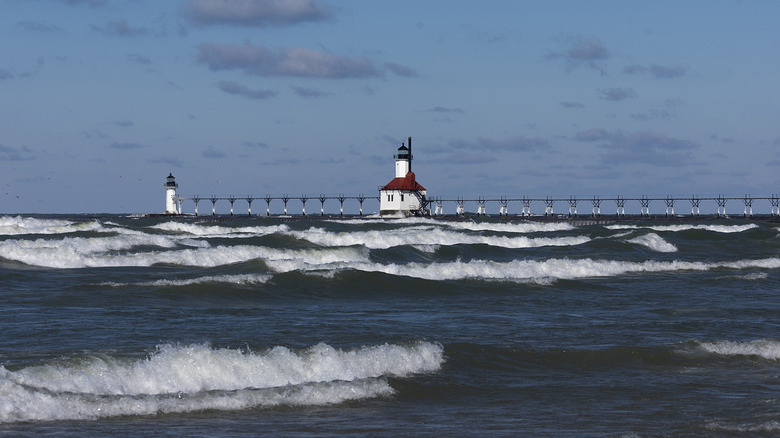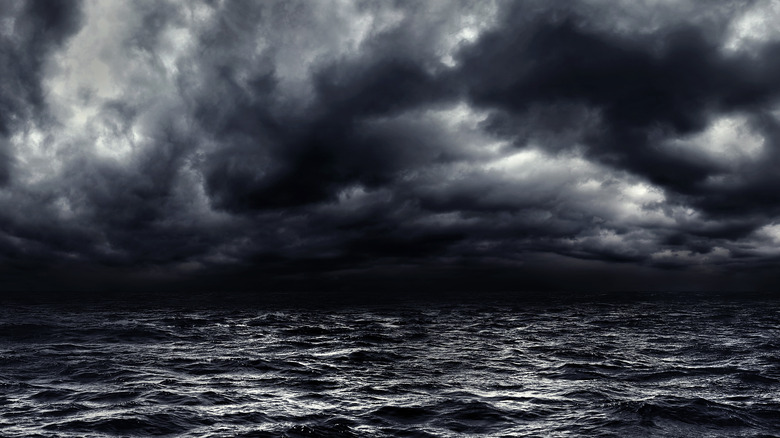Why You Should Think Twice Before Swimming In Lake Michigan
With its expansive shoreline, picturesque beaches, and cool freshwater, Lake Michigan offers an inviting escape during the hot summers for locals and tourists alike. Nestled among bustling cities like Chicago and Milwaukee, Lake Michigan makes for an easy natural escape that contrasts from the surrounding urban landscapes. Its waters, which reach as far as the eye can see, beckon swimmers to enjoy its far-reaching beauty. However, before you dive into this Great Lake, you may want to think twice.
Lake Michigan, the only Great Lake located entirely within the United States, spans approximately 22,400 square miles and touches the shores of Illinois, Indiana, Michigan, and Wisconsin. Major cities like Chicago and Milwaukee lie along its coastline. Despite its proximity to industrial areas, swimming in Lake Michigan isn't dangerous for the reasons you may initially believe. In fact, according to the State of the Great Lakes, Lake Michigan's water quality remains in generally good standing. Pollution from industrial runoff, agricultural activities, and urban waste can lead to elevated levels of harmful bacteria and chemicals, but conservation efforts have succeeded in keeping these contaminants low. So what exactly are the concerns with swimming in Lake Michigan?
The conditions are volatile
Between 2010 and July 1, 2024, there were 1,276 drownings reported in the five Great Lakes (via Great Lakes Surf Rescue Project). Lake Michigan alone is responsible for nearly half. The reason is that the lake is fraught with unexpected dangers that many visitors fail to avoid during their beach getaways.
Lake Michigan's vast size allows it to generate significant waves. In fact, first-time visitors often mistake the lake for the sea. On top of that, strong winds can quickly turn calm waters into turbulent ones that are challenging and dangerous for even experienced swimmers. These sudden changes can catch swimmers off guard, and make it difficult to exit the water swiftly. Rapid changes in winds also contribute to the development of thunderstorms, bringing lightning and heavy rain, which can create hazardous conditions almost without warning.
The lake is also notorious for its rip currents, especially during and after storms. While we tend to think of rip currents only occurring in larger bodies of water like the Pacific Ocean, they can occur even in lakes. Rip currents are powerful, narrow channels of fast-moving water that can pull swimmers away from shore. These currents are unpredictable and deadly. According to the National Weather Service, the Great Lakes experience rip currents regularly, with those in Lake Michigan having claimed multiple lives over the decades.
Limited safety precautions
Drowning is the most common way people die in Lake Michigan and understanding more about that lake helps illustrate why. If you do decide to take a dip in the lake, it is critical to take safety precautions.
First and foremost, try to swim in areas with a designated lifeguard. While some beaches along Lake Michigan have lifeguards on duty, many areas do not. Swimming in unguarded locations increases the risk of drowning and other emergencies going unnoticed, whether you're a strong swimmer or not.
On top of that, monitoring weather forecasts can help you make better-informed decisions about water activities during your stay. Wearing properly-fitted life jackets, and swimming with a companion nearby can also mean the difference between life or death in an unexpected scenario. By taking these precautions you can increase your safety and the safety of those around you, promoting an enjoyable experience at the lake.


